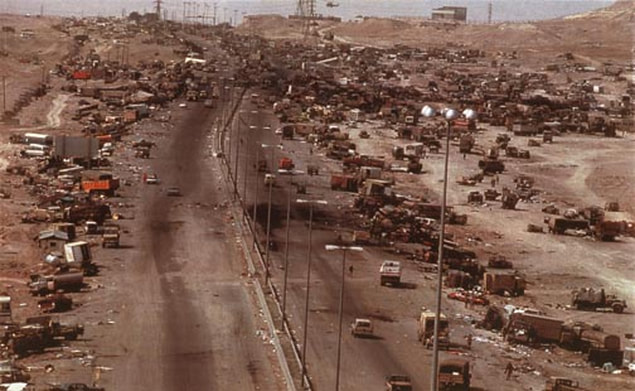The deaths took place during the operation in which American M1-A1 tanks of the First Infantry Division cut lanes through a 10-mile-wide stretch of barbed wire, minefields, bunkers and trenches north of the Iraqi-Saudi Arabian border on Feb. 24 as the allied ground offensive unfolded.
Army officials said the Iraqi soldiers who died remained in their trenches as plow-equipped tanks dumped tons of earth and sand onto them, filling the trenches to insure that they could not be used as cover from which to fire on allied units that were poised to pour through the gaps. Avoiding Hand-to-Hand Combat
The Army said it knew the operation would kill Iraqis who did not surrender or otherwise get out of the way, but said the tactic spared the lives of American soldiers who would have had to leave the safety of their armored vehicles and fight Iraqi troops hand to hand in the trenches.
Colonel Maggart, commander of one of two brigades that led assaults on a key line of Iraqi defenses, said in a telephone interview from Fort Riley, Kan., that between 80 and 250 Iraqis had been buried alive. Army officials said the First Infantry's experiences had been the only incidents of live burials during the war.
At a news conference here on Thursday, the Pentagon spokesman, Pete Williams, defended the tactic and said it did not violate the Geneva Conventions on the conduct of warfare. "I don't mean to be flippant, but there's no nice way to kill somebody in war," Mr. Williams said.
The disclosure of the live burials, which were first reported in Newsday this week, seems likely to add to the debate about how forthcoming the Pentagon has been in providing details about the toll suffered by the Iraqi Army at the hands of American forces.
Army officials strongly denied any attempts to hide the breaching operation, and pointed out that senior commanders had given extensive interviews about the maneuver after the war.
Journalists in combat pools were assigned to the First Infantry during the breaching operation, but none of their reports mentioned the live burials. In fact, the reports noted that few slain Iraqis had been visible in the bunkers and trenches.
The Pentagon has provided no official estimate of Iraq's overall casualties. The Defense Intelligence Agency issued a heavily qualified analysis in June estimating that 100,000 Iraqis had been killed and 300,000 wounded in the war but said the figures had a 50 percent margin of error.
Breaching operations are among the most dangerous maneuvers for ground troops. Obstacles like minefields and barbed wire can slow advancing forces, leaving them particularly vulnerable to enemy attack.
Colonel Maggart said two the First Infantry units had punched 16 tank-width lanes in the Iraqi defenses.
In most cases M1-A1 Abrams tanks mounted with a plow were positioned on either side of and parallel to the Iraqi trenches, the colonel said. The ditches were typically several hundred yards long, three feet wide and four feet deep. Operating like snowplows, the tanks drove alongside the ditches, filling them in. Colonel Maggart said that in most cases, Iraqi troops had enough time to see the plows coming, jump out of the trenches and surrender.
Gunners Beside Plow Tanks
For those Iraqi soldiers who continued to resist from outside the trenches, Bradley fighting vehicles equipped with heavy machine guns and 25-millimeter cannon drove alongside the plow tanks, Colonel Maggart said.
"The Iraqi soldiers that were killed in this process were those that chose to stay in their trenches or behind obstacles and fight during the breaching operation," Mr. Williams said. But neither Colonel Maggart nor Mr. Williams said how they could be sure that wounded Iraqi soldiers had been able to get out of the trenches in time.
Colonel Maggart estimated that the Iraqi forces he had faced had numbered between 800 and 1,000 -- the 110th Brigade of the 26th Iraqi Infantry Division -- and had had four T-55 tanks. No one was killed in Colonel Maggart's brigade, which consisted of 5,222 soldiers, 125 M1-A1 tanks and more than 50 Bradle fighting vehicles.
He said that the daytime breaching operation, including the ditch filling, had been completed in about three hours, and that the brigade had continued its advance after securing its breach zone, an area of roughly 35 square miles.
Source


 RSS Feed
RSS Feed